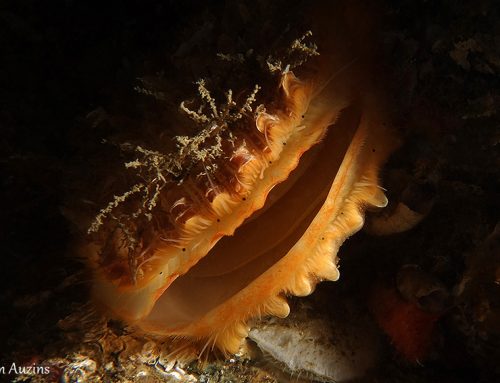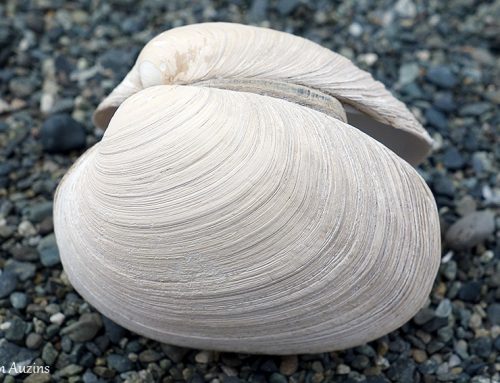While diving at the base of a rock wall I’ll often see green false-jingle (Pododesmus macrochisma) shells/valves on the ocean floor.
A green false-jingle will form to the shape of the rock, piling, or other solid surface to which it is attached. The colour of the mantle is highly varied and may be light peach to orange-red. This bivalve looks like a very thin clam, and has a round outline. The flattened lower shell (right valve) has a teardrop shaped hole in it, through which the green false-jingle attaches itself to a solid surface. The top shell (left valve) is slightly curved and may have radial ridges. The green false-jingle is also an important food source for the giant Pacific octopus (Enteroctopus dofleini) in Puget Sound. Another common name for this bivalve is jingle shell, which comes from the nice sound these shells make when many lower shells, strung together through the teardrop shaped holes, hit against one another. The green false-jingle grows to 5 inches (13 cm) in diameter, with a range that includes the Western Pacific to Japan, as well as Arctic Alaska to northern Mexico.
References:
Cowles, Dave. “Pododesmus macroschisma (Gray, 1850)” Invertebrates of the Salish Sea, Rosario Beach Marine Laboratory – a campus of Walla Walla University, 2005, https://inverts.wallawalla.edu/Mollusca/Bivalvia/Ostreoida/Anomiidae/Pododesmus_macroschisma.html
Fretwell, Kelly and Starzomski, Brian. “Green False-Jingle, Pododesmus macrochisma” Biodiversity of the Central Coast, University of Victoria, 2014, https://www.centralcoastbiodiversity.org/green-false-jingle-bull-pododesmus-macroschisma.html
Jensen, Gregory with Gotshall, Daniel and Flores-Miller, Rebecca. Beneath Pacific Tides: Subtidal Invertebrates of the West Coast. Bremerton: MolaMarine, 2018.






